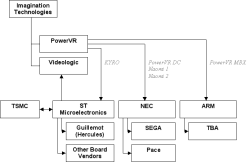Persistently late since the PCX2, and their concentration on Sega's Dreamcast console, you'd be forgiven for thinking that Videologic has a 'take it or leave it' attitude to the PC graphics card market. The announcement of PowerVR Series 3, A.K.A. KYRO, last year and the interminable wait for it to actually appear on the shelves did little to sway that impression.
That was how I began Beyond3D's Videologic Vivid! KYRO review, less than two months ago. Sometimes things can change quickly in this industry, and this time Videologic wants to make me eat my words!
Unless you've been hiding under a fully rendered Anisotropically filtered Multisample-AA'ed rock recently it may not have escaped your notice that a new kid has exited the PowerVR stable: KYROII. Now, finally, Beyond3D has gotten their hands on a preview board to put though its paces.
PowerVR? Imagination Technologies? ST? Videologic? Hercules? Huh??
There are a lot of company names floating around in conjunction with this chipset, and the relationship between them all is a little contrived; its not as cut and dried as the simple chip vendor / board vendor relationship NVIDIA an their partners have, and certainly not as simple as the likes of ATi and Matrox. So before we go any further I'd just like to clarify things a little.
Everything begins at the doorstep of Imagination Technologies (formerly Videologic). Imagination Technologies is in fact an umbrella name for several different divisions of the company; these divisions are 'PowerVR', 'Videologic', 'Ensigma' and the newly announced 'Metagence'. The Ensigma brand is focused upon emerging DSP technologies, and Metagence has an as yet unclear path (check the link to get a glimpse). PowerVR is an intellectual property company focused on 3D graphics cores. Videologic is the actual "products" division of Img Tech; they provide an outlet for various 3D products, as well as path finding for difficult or emerging technologies; they also do design work for other companies (they have previously provided speakers for TerraTech, and recently done some work for the high end Audio company Denon).
For the purposes of this preview we are primarily interested in the Img Tech divisions of PowerVR and Videologic…
PowerVR is responsible for the actual design of the 3D chipset cores, and they license these cores to other parties to produce (much akin to the business model we heard of for GigaPixel, before the were purchased by 3dfx - the difference being that PowerVR had been doing it longer, and have had far more success with it!). PowerVR have several licensees, which in turn will sell the produced chipsets on. The image below shows PowerVR licensees and some of the end customers.
In the case of KYRO/KYROII, ST Microelectronics has licensed the core from PowerVR. ST is then responsible for turning the design into an actual transistor layout from it to put into silicon. Once that has occurred the normal process of tape out, transference to the silicon fab and receiving the initial silicon occurs. Once the initial silicon is back the chip obviously undergoes testing - at this point ST will need intervention of PowerVR again to make sure the bugs are ironed out before the tape out for final production silicon. The actual roadmap for PowerVR designs is held by Img Tech, however ST does have room to negotiate within that roadmap; for instance the original design of KYRO was based on a .25um silicon process, however for KYROII ST has taken the KYRO core, which they licensed, and redesigned the silicon layout on a .18um process (that obviously facilitates the increase in core speed that KYROII has over KYRO).
ST Microelectronics has their own silicon FAB's, and are capable of producing chips themselves (NVIDIA's NV1 was fabbed by ST, as was, I believe, KYRO). However, until recently ST had no .18um capacity, and as such KYROII is currently fabbed by TSMC. ST has invested heavily in TSMC over the years and they have a fixed production capacity agreed with them, should it be required.
Once ST has a chip ready they are free to seek deals for the sales of those chips, through AIB's or OEM's. It is traditional for Videologic to pick up and sell one the of PowerVR designed chips, predominantly for sale in the UK market, but also some others in Europe; Videologic will pay the same price as any of the other vendors for the chip. For KYRO ST also sold to some far east vendors such as Inno or Powercolor; however, as it may not have escaped your notice, they have gained the allegiance of the well known board vender Hercules for KYROII. I have no doubt that ST will be seeking further board vendors and even OEM deals.
Through both PowerVR and Videologic Img Tech also give support to both ST and ST's other board vendors. For instance all of the reference drivers for the KYRO chipsets are written by PowerVR, and the board vendors either just use them, or provide customisations on them for any board level difference there may be. All developer support is also undertaken by PowerVR, which can range from simple game compatibility testing / issues to supporting the developer as to how to implement KYRO's features in their games; and Videologic will also provide board level support to the other vendors - for instance they provided the reference board design for Hercules, which is what most of the preview boards sent out so far have been based upon.

